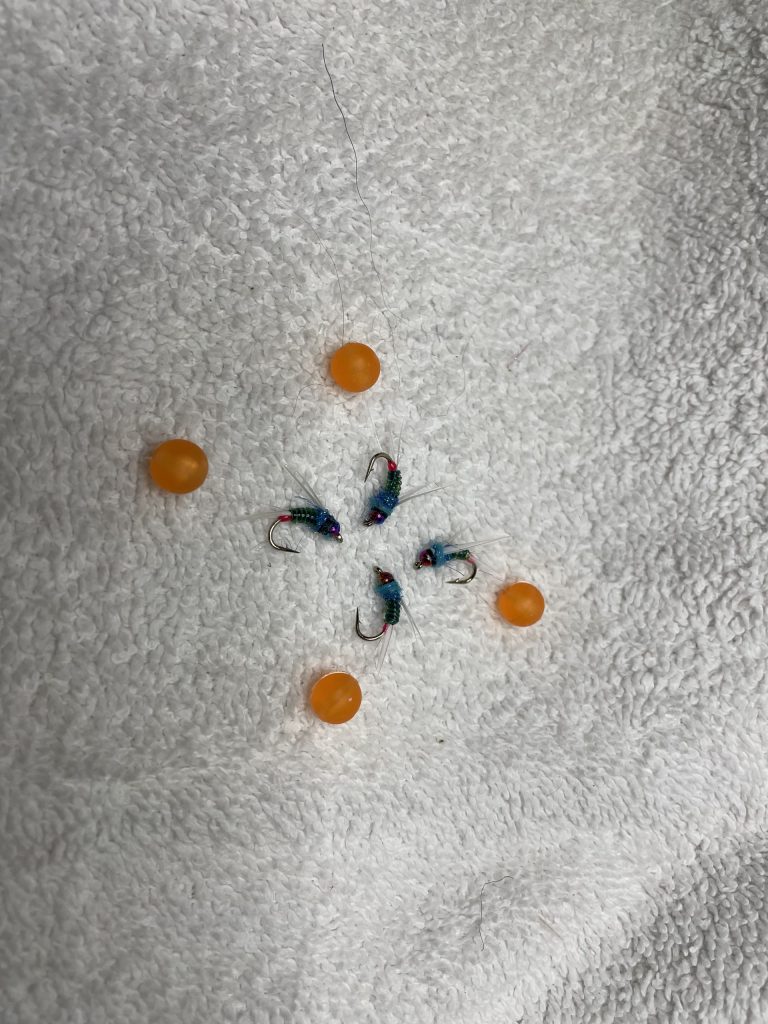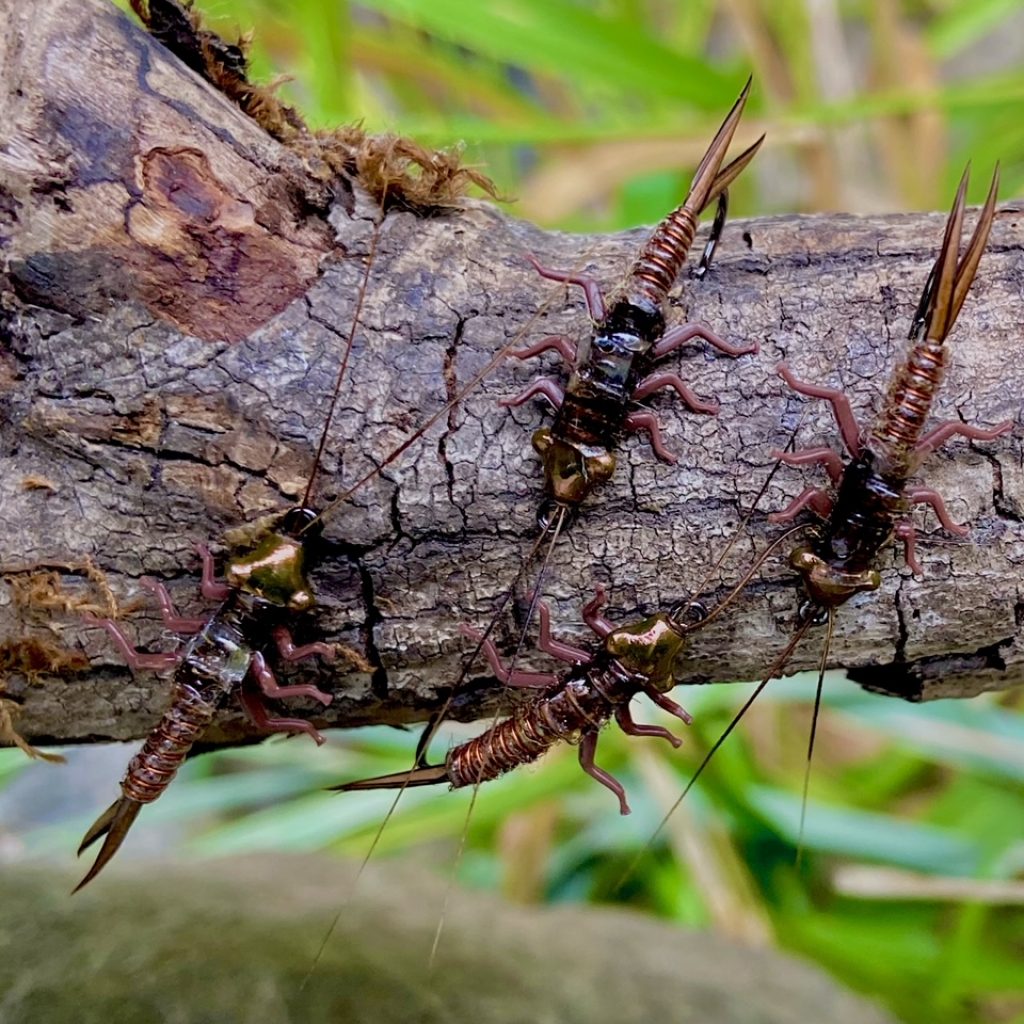NEWS & STORIES
Meet the Winners: The 9th Annual Fly Tying Competition
We are pleased to announce the winners of the 9th Annual Project Healing Waters Fly Fishing National Fly Tying Competition! Following an exciting Public Judging Round (during which over 3,000 votes were cast!), six finalists in each category proceeded to the Finals Round to be judged by an expert panel who determined 1st, 2nd & 3rd place in each category. Click here to meet the judges
Now in its 9th year, the Project Healing Waters Fly Tying Competition is focused on expanding the therapeutic experience for PHWFF disabled veterans participants by giving them the opportunity to showcase their fly tying skills and creativity in a fun contest.
MEET THE WINNERS
Category 1: Beginner
This category is for participants new to fly tying with less than one year of fly tying experience.
3rd Place
John Krahe: Stone and Eggs | PHWFF Erie, PA
I am a Iraq combat veteran. I have a total of 26 years of service . 12 years with the active Marines and 14 years with the Army NG. I looked into PHWFF at the request of one of my therapists. Never thinking it would do anything I figured I would go and ” check the box .” Boy was I wrong. I find nothing better then standing in the cold stream listening to the water babbling along.
I love that I can actually create something with my own hands, that isn’t destructive and helps me clear my mind. It has helped with patience and to try and be creative.
Jon Krahe, PHWFF Erie, PA
2nd Place
Sean Brown: Quill Body BWO | PHWFF Joint Base Lewis-McChord, WA
I struggled for a long time after the Army. I felt lost and empty. When I found fly tying something inside of me just clicked. I found focus and calm, it was like someone turned off the noise. It has made me a better problem solver, more patient, and thoughtful. When your thread breaks or something doesn’t go right you can get upset or you can learn a new way to do something. Worst case, the way not to do something. This has made me a better student, a better person, and a more complete individual and I am very thankful for all the help from the guys in the JBLM program.
This was the first fly I ever played with to find the right recipe for what I was trying to do. I started out with a pattern I got from George Daniel and started changing things based on what I had, then it morphed into trying to create a personal go to that was a quick tie, and durable. I tried different UV resins, synthetic quills, real quills, with the red collar, without the red collar, etc. but this has been my favorite. Mainly because this has been the most durable, but also because it has worked in just about every situation I have fished it.
Sean Brown, PHWFF JBLM WA
1st Place
Alexander Ward: Wally Wing Mayfly | PHWFF Atlanta, GA
I wanted to express the simplicity in materials and focus on technique.
Those rough days and nights when I can’t get on the water, fly tying has filled that void until I can get out and cast a line. Tying has not only been a stop-gap for me but has elevated my experience on the water. Having a productive day on the water with a fly that I tied has been a game-changer. I no longer dread losing flies. I look at it as an excuse to tie more for the next trip.
Alex Ward , PHWFF Atlanta, GA
CATEGORY 2: INTERMEDIATE
This category is for participants with two to three years of fly tying experience.
3rd Place
John Rister: Peacock Jewel Moth Imitation | PHWFF Chattanooga, TN
I wanted to do something natural but also with pretty colors. I stared looking at various moth and butterfly images on the net. I came across the Peacock Jewel Moth and was amazed at how beautiful it was and how the hgw colors popped. So I set out to figure out how to make one. I started with some amherst feathers and tied them on a hook to see if I could even get them to sit like wings. Once I new I could I got my materials together and had to figure out how to shape the wings. So i made a template that a used to rough cut the wings to form and then had to freehand sculpt them to get the flowing natural shape I was looking for.
I enjoy the peace and tranquility in fly tying. A stressful day at work can go easily be fixed by a fly tying session. I also enjoy that I can make something beautiful like I attempted to do with my moth imitation or crank out quick and functional flies for your next fishing trip. You can be as simple or as complicated as you want. My father and grandfather were excellent woodworkers. Me not so much. But I feel like fly tying is my woodworking. I won’t say it comes easily but I can look at material and envision a fly and sit down and tie that fly. This is what i enjoy about fly tying.
John Rister, PHWFF Chattanooga, TN
2nd Place
Justin Fordice: Classic Stonefly | PHWFF Joint Base Lewis-McChord, WA
The reason I chose the stonefly is because I have not seen many nymphs in the competition. This fly is special to me because the stonefly is one of the main food sources for big fish on the river I grew up fishing, the Grande Ronde river in NE Oregon. I remember walking along the banks as a kid and plucking these bugs off the rocks. The stonefly reminds me of home.
Fly tying stimulates my focus and attention to a therapeutic activity that provides an escape from the busy stressors of everyday life. I find myself ultra focused on the details, size, shape, color, and dimensions of the fly, trying to make it as realistic as possible. Like most, catching a fish on a fly I tied is the ultimate feeling of accomplishment. I used to buy flies but in the past 2 years have replaced all of my purchased flies with flies I’ve tied myself
Justin Fordice, PHWFF JBLM WA
1st Place
Michael Bretz: Klinkhammer | PHWFF St. Louis, MO
I loved the Klinkhammer the 1st time I saw it. I love that there are so many ways and materials you can use. I choose the pink hot spot from a tip from a trout hatchery manager named Ben. He told me about how his fish love the pink hot spot. I had to add it to this example of the Klinkhammer.
Fly tying is a nice way to relax at the end of the day. No matter how bad my day went, I can sit at my desk and enjoy tying a few flies. I remember some of my fishing trips, and the next thing I know I smiling and have a couple laughs to myself.
Michael Bretz, PHWFF St. Louis, MO
CATEGORY 3: ADVANCED
This category is for participants with four or more years of fly tying experience.
3rd Place
Christian Fritz: The Purple Devil | PHWFF San Marcos, TX
I call this fly the Purple Devil as it is loosely based on the Lance Eagan Tasmanian Devil.
I enjoy the peace and purpose involved in fly tying the most. When I sit down to tie some flies, I prefer to have a goal in mind, like tie 12 Pat’s rubber legs, or 18 elk hair caddis. Then I get out all the supplies I need and I start tying. While I’m tying, I’m not worried about school or bills or pain or that constant ringing in my ear. I’m just tying. And even goal I chose for tying is generally tied to a greater goal of fishing. I decide I need Pat’s rubber legs because I know I’ll be fishing fast or deep water and need flies that will get down quickly. It keeps me focused on both short term and long term goals.
Christian Fritz, PHWFF San Marcos, TX
2nd Place
John Rogers: UV Spring Creek Scud | PHWFF Altoona, PA
The purpose of this fly was to be unique yet realistic enough to fool trout that see countless flies daily. The UV resin is used to help maintain a slim profile and allow the fly to sink appropriately without the use of lead wraps. In order to increase the weight without bulk, a tungsten bead was used in the place of a brass bead.
One of the things I enjoy most about fly tying is the ability to be creative. I can create flies that are unique to an area then tailor them to my specific needs. Whether it be the size of the fly, color or more often than not adjusting the weight of the fly to my fishing needs. This creativity also makes the experience more memorable because I catch the fish on a fly I created and tailored to my own specific design.
John Rogers, PHWFF Altoona, PA
1st Place
Jeff White: Wally Wing Mayfly Spinner | PHWFF Winston-Salem, NC
I chose the mayfly because for many anglers no other insect symbolizes fly fishing in streams more than this delicate creature. According to fly fishing historians the earliest writings and drawings about fly fishing tell of and depict anglers catching fish with mayfly imitations.
The fly for consideration is an imitation of an adult male yellowish sulphur mayfly which after molting into a spinner, mates and lives less than two days. It then falls into the water with outstretched wings – spent. All God’s creatures have their appointed season. The mayfly too has its moment and time enough.
For me fly tying is both art form and discipline, imitating nature and relishing nature’s example. I love trying different patterns and learning new techniques, all the while exploring my creativity. And what could be more satisfying than catching a fish on one’s fly?… the joy of giving one’s fly to a family member or friend and watching them catch a fish!
Jeff White, PHWFF Winston-Salem, NC
Join us in celebrating the tremendous talents of all those PHWFF participants who participated this year!
CONGRATS!
The PHWFF Fly Tying Competition has grown each year since it’s inception in 2012 and since that time we have been delighted and astounded to see the remarkable patterns and flies submitted from PHWFF programs across the country. A special thanks to all those volunteers and programs who made this annual competition such a success.
Latest News
- PHW to Participate in Wreaths Across America’s National Wreaths Across America Day
- 2025 Healing on the Fly Gala — Celebrating 20 Years of Healing America’s Veterans
- Golden Corral® Round-Up Supports Veterans’ Healing Journeys
- Golden Corral® Launches PHW Fundraising Initiative
- A Final Cast at Mossy Creek: Honoring 17 Years of Healing and Legacy







































